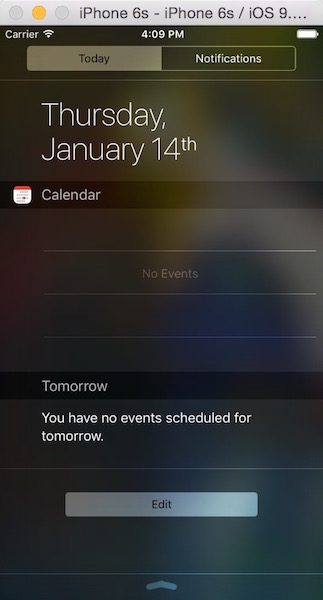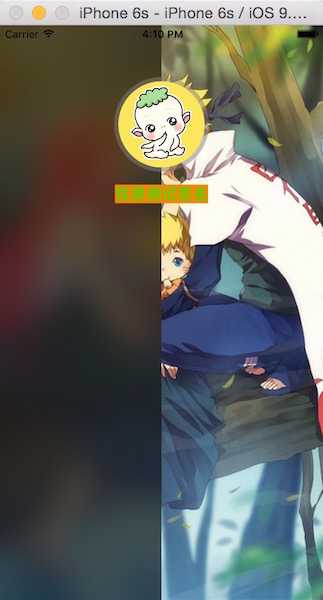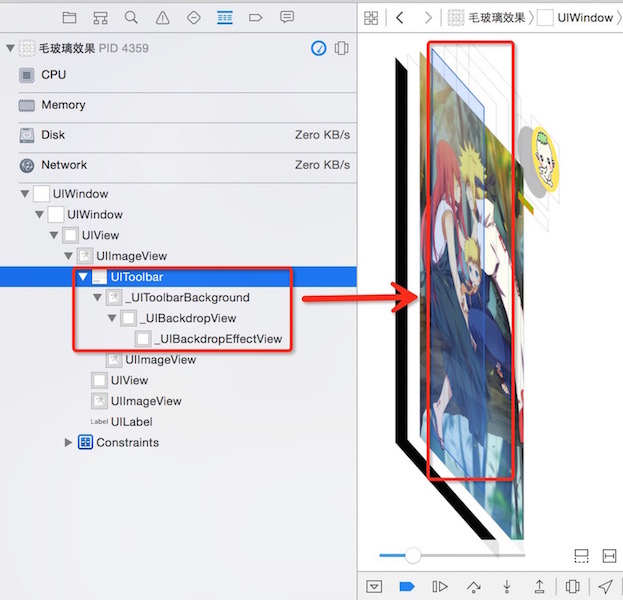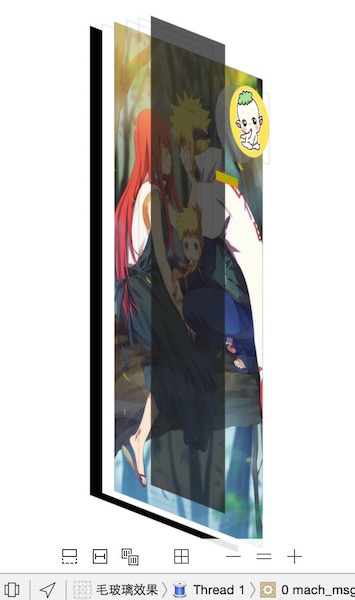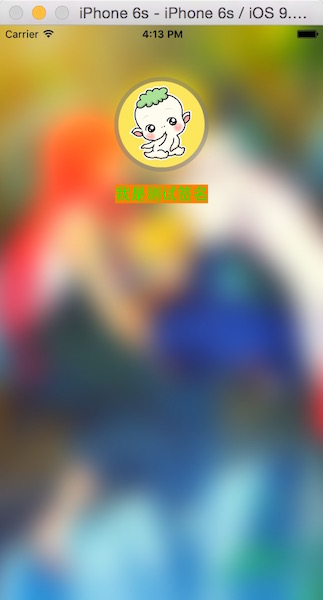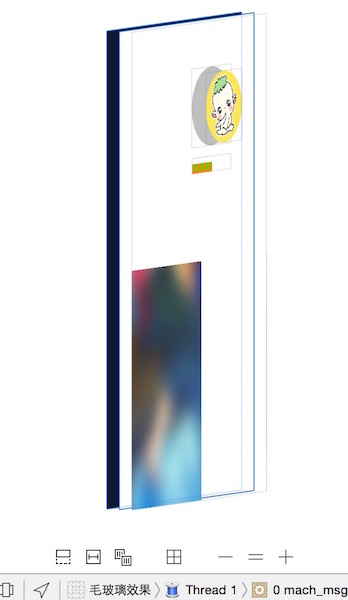app设计时往往会用到一些模糊效果或者毛玻璃效果,ios目前已提供一些模糊api可以让我们方便是使用。
话说苹果在ios7.0之后,很多系统界面都使用了毛玻璃效果,增加了界面的美观性,比如下图的通知中心界面;
但是其ios7.0的sdk并没有提供给开发者实现毛玻璃效果的api,所以很多人都是通过一些别人封装的框架来实现,后面我也会讲到一个;
其实在ios7.0(包括)之前还是有系统的类可以实现毛玻璃效果的, 就是 uitoolbar这个类,并且使用相当简单,几行代码就可以搞定.
下面是代码实现:
创建一个uitoolbar实例,设置它的frame或者也可以通过添加约束
然后uitoolbar有一个属性:barstyle,设置对应的枚举值来呈现毛玻璃的样式,最后再添加到需要进行毛玻璃效果的view上即可.
|
1
2
3
4
5
6
7
8
9
10
11
12
13
|
/*
毛玻璃的样式(枚举)
uibarstyledefault = ,
uibarstyleblack = ,
uibarstyleblackopaque = , // deprecated. use uibarstyleblack
uibarstyleblacktranslucent = , // deprecated. use uibarstyleblack and set the translucent property to yes
*/
uiimageview *bgimgview = [[uiimageview alloc] initwithframe:self.view.bounds];
bgimgview.image = [uiimage imagenamed:@"huoying.jpg"];
[self.view addsubview:bgimgview];
uitoolbar *toolbar = [[uitoolbar alloc] initwithframe:cgrectmake(, , bgimgview.frame.size.width*., bgimgview.frame.size.height)];
toolbar.barstyle = uibarstyleblacktranslucent;
[bgimgview addsubview:toolbar];
|
效果图:
我们再来看看视图结构:
通过视图结构可以看到uitoolbar包含了三个子视图
一个背景图片和1个背景view,还有1个背景特效view,正是这几个视图结合在一起实现了毛玻璃的效果
在ios8.0之后,苹果新增了一个类uivisualeffectview,通过这个类来实现毛玻璃效果与上面的uitoolbar一样,而且效率也非常之高,使用也是非常简单,几行代码搞定. uivisualeffectview是一个抽象类,不能直接使用,需通过它下面的三个子类来实现(uiblureffect, uivisualeffevt, uivisualeffectview);
子类uiblureffect只有一个类方法,用来快速创建一个毛玻璃效果,参数是一个枚举,用来设置毛玻璃的样式,而uivisualeffectview则多了两个属性和两个构造方法,用来快速将创建的毛玻璃添加到这个uivisualeffectview上.
特别注意: 这个类是ios8.0之后才适用, 所以如果项目要兼容ios7.0的话, 还是要考虑其它的两种方法了.
下面来看看实现代码:
同样是先快速的实例化uiblureffect并设置毛玻璃的样式,然后再通过uivisualeffectview的构造方法将uiblureffect的实例添加上去最后设置frame或者是通过添加约束, 将effectview添加到要实现了毛玻璃的效果的view控件上,效果图和上面的一样.
|
1
2
3
4
5
6
7
8
9
10
11
12
13
14
15
16
|
uiimageview *bgimgview = [[uiimageview alloc] initwithframe:self.view.bounds];
bgimgview.image = [uiimage imagenamed:@"huoying.jpg"];
bgimgview.contentmode = uiviewcontentmodescaleaspectfill;
//[bgimgview setimagetoblur: [uiimage imagenamed:@"huoying.jpg"] blurradius: completionblock:nil];
bgimgview.userinteractionenabled = yes;
[self.view addsubview:bgimgview];
/*
毛玻璃的样式(枚举)
uiblureffectstyleextralight,
uiblureffectstylelight,
uiblureffectstyledark
*/
uiblureffect *effect = [uiblureffect effectwithstyle:uiblureffectstyledark];
uivisualeffectview *effectview = [[uivisualeffectview alloc] initwitheffect:effect];
effectview.frame = cgrectmake(, , bgimgview.frame.size.width*., bgimgview.frame.size.height);
[bgimgview addsubview:effectview];
|
但是我们来看看视图结构,大家会发现和toolbar不一样哦!
其实是因为uivisualeffectview这个类,构造方法帮我们创建了一个view,而这个view我们给它做了毛玻璃处理,再将其覆盖到了背景图之上
嗯! 最后再来给大家介绍一个国外大神封装的uiimageview的分类,里面不管是怎么实现的,反正使用非常简单,只要一句代码就搞定.
下面先看代码:
|
1
2
3
4
5
6
7
|
uiimageview *bgimgview = [[uiimageview alloc] initwithframe:self.view.bounds];
//bgimgview.image = [uiimage imagenamed:@"huoying.jpg"];
bgimgview.contentmode = uiviewcontentmodescaleaspectfill;
// 对背景图片进行毛玻璃效果处理 参数blurradius默认是,可指定,最后一个参数block回调可以为nil
[bgimgview setimagetoblur: [uiimage imagenamed:@"huoying.jpg"] blurradius: completionblock:nil];
bgimgview.userinteractionenabled = yes;
[self.view addsubview:bgimgview];
|
效果图:
再来看看添加毛玻璃效果后的视图结构:
哈哈哈, 大家应该看懂了, 这是直接对背景图片进行了高斯模糊处理了,其它就不解释了.
好啦, 反正ios中要进行毛玻璃效果处理就这几种方式,看大家的需求,喜欢用哪种就用哪种吧.
上面的demo,包括大神封装的分类,如果需要详细的源代码的话,可以到我的github上clone啦!有问题欢迎留言一起探讨学习.
下面给大家介绍图片模糊效果的三种方法
第一种使用core image进行模糊
|
1
2
3
4
5
6
7
8
9
10
|
- (uiimage *)blurryimage:(uiimage *)image
withblurlevel:(cgfloat)blur {
ciimage *inputimage = [ciimage imagewithcgimage:image.cgimage];
cifilter *filter = [cifilter filterwithname:@"cigaussianblur"
keysandvalues:kciinputimagekey, inputimage,
@"inputradius", @(blur),
]; ciimage *outputimage = filter.outputimage;
cgimageref outimage = [self.context createcgimage:outputimage
fromrect:[outputimage extent]];
return [uiimage imagewithcgimage:outimage]; }
|
第二种使用vimage api进行模糊
|
1
2
3
4
5
6
7
8
9
10
11
12
13
14
15
16
17
18
19
20
21
22
23
24
25
26
27
28
29
30
31
32
33
34
35
36
37
38
39
40
41
42
43
44
45
46
47
48
49
50
51
52
53
54
55
|
- (uiimage *)blurryimage:(uiimage *)image withblurlevel:(cgfloat)blur {
if (blur < 0.f || blur > 1.f) {
blur = 0.5f;
}
int boxsize = (int)(blur * 100);
boxsize = boxsize - (boxsize % 2) + 1;
cgimageref img = image.cgimage;
vimage_buffer inbuffer, outbuffer;
vimage_error error;
void *pixelbuffer;
cgdataproviderref inprovider = cgimagegetdataprovider(img);
cfdataref inbitmapdata = http://www.open-open.com/code/view/cgdataprovidercopydata(inprovider);
inbuffer.width = cgimagegetwidth(img);
inbuffer.height = cgimagegetheight(img);
inbuffer.rowbytes = cgimagegetbytesperrow(img);
inbuffer.data = (void*)cfdatagetbyteptr(inbitmapdata);
pixelbuffer = malloc(cgimagegetbytesperrow(img) *
cgimagegetheight(img));
if(pixelbuffer == null)
nslog(@"no pixelbuffer");
outbuffer.data = pixelbuffer;
outbuffer.width = cgimagegetwidth(img);
outbuffer.height = cgimagegetheight(img);
outbuffer.rowbytes = cgimagegetbytesperrow(img);
error = vimageboxconvolve_argb8888(&inbuffer,
&outbuffer,
null,
0,
0,
boxsize,
boxsize,
null,
kvimageedgeextend);
if (error) {
nslog(@"error from convolution %ld", error);
}
cgcolorspaceref colorspace = cgcolorspacecreatedevicergb();
cgcontextref ctx = cgbitmapcontextcreate(
outbuffer.data,
outbuffer.width,
outbuffer.height,
8,
outbuffer.rowbytes,
colorspace,
kcgimagealphanoneskiplast);
cgimageref imageref = cgbitmapcontextcreateimage (ctx);
uiimage *returnimage = [uiimage imagewithcgimage:imageref];
//clean up
cgcontextrelease(ctx);
cgcolorspacerelease(colorspace);
free(pixelbuffer);
cfrelease(inbitmapdata);
cgcolorspacerelease(colorspace);
cgimagerelease(imageref);
return returnimage; }
|
第三种方法是网上找到的(毛玻璃效果)
|
1
2
3
4
5
6
7
8
9
10
11
12
13
14
15
16
17
18
19
20
21
22
23
24
25
26
27
28
29
30
31
32
33
34
35
36
37
38
39
40
41
42
43
44
45
46
47
48
49
50
51
52
53
54
55
56
57
58
59
60
61
62
63
64
65
66
67
68
69
70
71
72
73
74
75
76
77
78
79
80
81
82
83
84
85
86
87
|
// 内部方法,核心代码,封装了毛玻璃效果 参数:半径,颜色,色彩饱和度- (uiimage *)imagebluredwithradius:(cgfloat)blurradius tintcolor:(uicolor *)tintcolor saturationdeltafactor:(cgfloat)saturationdeltafactor maskimage:(uiimage *)maskimage {
cgrect imagerect = { cgpointzero, self.size };
uiimage *effectimage = self; bool hasblur = blurradius > __flt_epsilon__;
bool hassaturationchange = fabs(saturationdeltafactor - 1.) > __flt_epsilon__; if (hasblur || hassaturationchange) { uigraphicsbeginimagecontextwithoptions(self.size, no, [[uiscreen mainscreen] scale]);
cgcontextref effectincontext = uigraphicsgetcurrentcontext();
cgcontextscalectm(effectincontext, 1.0, -1.0);
cgcontexttranslatectm(effectincontext, 0, -self.size.height);
cgcontextdrawimage(effectincontext, imagerect, self.cgimage);
vimage_buffer effectinbuffer; effectinbuffer.data = http://www.open-open.com/code/view/cgbitmapcontextgetdata(effectincontext);
effectinbuffer.width = cgbitmapcontextgetwidth(effectincontext);
effectinbuffer.height = cgbitmapcontextgetheight(effectincontext);
effectinbuffer.rowbytes = cgbitmapcontextgetbytesperrow(effectincontext);
uigraphicsbeginimagecontextwithoptions(self.size, no, [[uiscreen mainscreen] scale]);
cgcontextref effectoutcontext = uigraphicsgetcurrentcontext();
vimage_buffer effectoutbuffer;
effectoutbuffer.data = cgbitmapcontextgetdata(effectoutcontext);
effectoutbuffer.width = cgbitmapcontextgetwidth(effectoutcontext);
effectoutbuffer.height = cgbitmapcontextgetheight(effectoutcontext);
effectoutbuffer.rowbytes = cgbitmapcontextgetbytesperrow(effectoutcontext); if (hasblur) { cgfloat inputradius = blurradius * [[uiscreen mainscreen] scale];
nsuinteger radius = floor(inputradius * 3. * sqrt(2 * m_pi) / 4 + 0.5);
if (radius % 2 != 1) {
radius += 1; // force radius to be odd so that the three box-blur methodology works.
}
vimageboxconvolve_argb8888(&effectinbuffer, &effectoutbuffer, null, 0, 0, (short)radius, (short)radius, 0, kvimageedgeextend); vimageboxconvolve_argb8888(&effectoutbuffer, &effectinbuffer, null, 0, 0, (short)radius, (short)radius, 0, kvimageedgeextend); vimageboxconvolve_argb8888(&effectinbuffer, &effectoutbuffer, null, 0, 0, (short)radius, (short)radius, 0, kvimageedgeextend);
}
bool effectimagebuffersareswapped = no;
if (hassaturationchange) {
cgfloat s = saturationdeltafactor;
cgfloat floatingpointsaturationmatrix[] = {
0.0722 + 0.9278 * s, 0.0722 - 0.0722 * s, 0.0722 - 0.0722 * s,
0,
0.7152 - 0.7152 * s, 0.7152 + 0.2848 * s, 0.7152 - 0.7152 * s,
0,
0.2126 - 0.2126 * s, 0.2126 - 0.2126 * s, 0.2126 + 0.7873 * s,
0,
0,
0,
0,
1,
};
const int32_t divisor = 256;
nsuinteger matrixsize = sizeof(floatingpointsaturationmatrix)/sizeof(floatingpointsaturationmatrix[0]); int16_t saturationmatrix[matrixsize]; for (nsuinteger i = 0; i < matrixsize; ++i) {
saturationmatrix[i] = (int16_t)roundf(floatingpointsaturationmatrix[i] * divisor);
}
if (hasblur) {
vimagematrixmultiply_argb8888(&effectoutbuffer, &effectinbuffer, saturationmatrix, divisor, null, null, kvimagenoflags);
effectimagebuffersareswapped = yes;
}
else {
vimagematrixmultiply_argb8888(&effectinbuffer, &effectoutbuffer, saturationmatrix, divisor, null, null, kvimagenoflags);
}
}
if (!effectimagebuffersareswapped)
effectimage = uigraphicsgetimagefromcurrentimagecontext();
uigraphicsendimagecontext();
if (effectimagebuffersareswapped)
effectimage = uigraphicsgetimagefromcurrentimagecontext();
uigraphicsendimagecontext();
}
// 开启上下文 用于输出图像
uigraphicsbeginimagecontextwithoptions(self.size, no, [[uiscreen mainscreen] scale]);
cgcontextref outputcontext = uigraphicsgetcurrentcontext();
cgcontextscalectm(outputcontext, 1.0, -1.0);
cgcontexttranslatectm(outputcontext, 0, -self.size.height);
// 开始画底图 cgcontextdrawimage(outputcontext, imagerect, self.cgimage);
// 开始画模糊效果
if (hasblur)
{
cgcontextsavegstate(outputcontext);
if (maskimage)
{
cgcontextcliptomask(outputcontext, imagerect, maskimage.cgimage);
} cgcontextdrawimage(outputcontext, imagerect, effectimage.cgimage);
cgcontextrestoregstate(outputcontext);
}
// 添加颜色渲染
if (tintcolor)
{
cgcontextsavegstate(outputcontext);
cgcontextsetfillcolorwithcolor(outputcontext, tintcolor.cgcolor);
cgcontextfillrect(outputcontext, imagerect);
cgcontextrestoregstate(outputcontext);
}
// 输出成品,并关闭上下文
uiimage *outputimage = uigraphicsgetimagefromcurrentimagecontext();
uigraphicsendimagecontext();
return outputimage;}
|
相关文章
- 个人服务器网站搭建:如何选择适合自己的建站程序或框架? 2025-06-10
- 64M VPS建站:能否支持高流量网站运行? 2025-06-10
- 64M VPS建站:怎样选择合适的域名和SSL证书? 2025-06-10
- 64M VPS建站:怎样优化以提高网站加载速度? 2025-06-10
- 64M VPS建站:是否适合初学者操作和管理? 2025-06-10
- 2025-07-10 怎样使用阿里云的安全工具进行服务器漏洞扫描和修复?
- 2025-07-10 怎样使用命令行工具优化Linux云服务器的Ping性能?
- 2025-07-10 怎样使用Xshell连接华为云服务器,实现高效远程管理?
- 2025-07-10 怎样利用云服务器D盘搭建稳定、高效的网站托管环境?
- 2025-07-10 怎样使用阿里云的安全组功能来增强服务器防火墙的安全性?
快网idc优惠网
QQ交流群
-
2025-06-04 44
-
2025-05-27 57
-
2025-06-04 75
-
2025-05-29 49
-
2025-05-27 35


